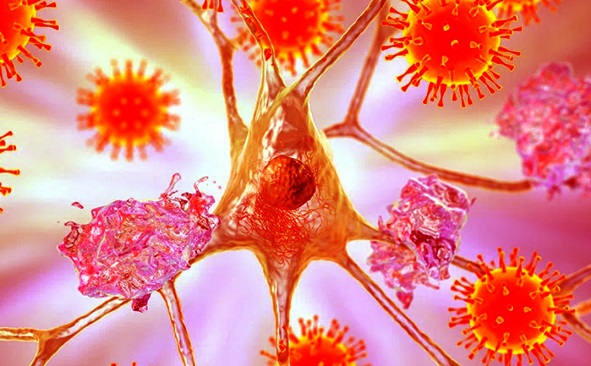Italian Scientist Warn That SARS-CoV-2 Spike Proteins Kills Brain Cells Directly Via Necroptosis!
Nikhil Prasad Fact checked by:Thailand Medical News Team Jun 02, 2025 7 months, 6 days, 6 hours, 37 minutes ago
Medical News: Spike Protein from COVID-19 Infections May Cause Hidden Brain Damage Through Nerve Cell Death
In a troubling new discovery, scientists from Italy have revealed that the S1 subunit of the SARS-CoV-2 Spike protein—the part that helps the virus enter human cells—can directly damage and kill brain cells even without the full virus being present. Researchers from the Department of Neuroscience, Reproductive and Dentistry Sciences at Federico II University of Naples and the Department of Neuroscience and Brain Technologies at the Istituto Italiano di Tecnologia in Genova have found alarming evidence that this Spike protein segment can enter brain cells and trigger a form of programmed cell death called necroptosis.
 Italian Scientist Warn That SARS-CoV-2 Spike Proteins Kills Brain Cells Directly Via Necroptosis
Italian Scientist Warn That SARS-CoV-2 Spike Proteins Kills Brain Cells Directly Via Necroptosis
This
Medical News report delves into their findings, which provide a possible explanation for the severe neurological issues seen in many COVID-19 patients, both during the acute infection and in those suffering from Long COVID.
Spike S1 Alone Can Kill Neurons
Using laboratory-grown human nerve cells (SH-SY5Y cells), the scientists found that exposing the cells to just the S1 part of the Spike protein caused them to die off over time. Interestingly, when they exposed cells to the S2 portion or even the entire Spike protein, the effect was not as severe. This indicates that the S1 segment alone is highly toxic to nerve cells.
What made this finding even more worrisome is that the S1 protein can travel across the blood-brain barrier—a protective shield meant to keep harmful substances out of the brain—and enter the central nervous system. Once inside, it binds to a brain cell surface receptor known as Neuropilin-1 (NRP1), slips into the cell, and sets off a destructive chain reaction.
The Deadly Molecular Domino Effect
The researchers discovered a series of molecular events inside the neurons that begin once S1 enters. The first key player is an enzyme called HDAC4, which becomes overactive. This enzyme interferes with a protective molecule known as CREB. When CREB levels drop, another molecule called RIPK1 becomes more active. RIPK1 is known to trigger necroptosis—a form of inflammatory cell death. Essentially, the Spike S1 subunit hijacks the cell’s own processes and turns them against it.
To confirm this, the team used specific drugs and genetic tools. They silenced HDAC4 using RNA techniques, and also tested a drug called Necrostatin-1, which blocks RIPK1. Both approaches helped protect the nerve cells from dying, confirming that this destructive pathway—NRP1 → HDAC4 → CREB ↓ → RIPK1 ↑—is key to the damage.
Spike Protein Makes Stroke Outcomes Worse
The study also explored how this toxic protein affects brain cells under stress. Using a laboratory model of ischemic stroke (where blood flow is blocked
and then restored), the researchers showed that the presence of the S1 protein made the damage even worse. Cells exposed to both the S1 protein and stroke-like conditions showed dramatically higher death rates compared to either one alone.
When researchers blocked the key steps in the molecular pathway—by silencing NRP1, HDAC4, or RIPK1—they were able to reduce this additive brain cell damage. However, knocking down the protective CREB protein made things worse. This strengthens the idea that S1 accelerates neuron death by shutting down the brain’s natural defense systems.
How the Spike S1 Protein Sneaks into Brain Cells
Another fascinating finding was that the S1 protein doesn’t use the commonly known ACE2 receptor to enter neurons. Instead, it mainly hijacks the NRP1 receptor. Using experiments involving specially prepared neurons, the researchers showed that silencing NRP1 stopped the S1 protein from entering the cells and prevented the resulting damage.
The team also used an endocytosis blocker—Sodium Azide—to stop the protein from being internalized. This treatment reduced both the movement of the S1 protein into the cell’s interior and the toxic effects it caused.
Implications for Long COVID and Vaccine Safety
This research sheds light on why so many people with COVID-19, especially those with long-term symptoms, complain of neurological issues like memory loss, brain fog, strokes, and even psychiatric problems. It also raises questions about whether small pieces of Spike protein—whether from infection or possibly from mRNA-based vaccines that instruct cells to make the Spike—could contribute to neuroinflammation or damage in some people.
This study suggests that more research is needed to understand the long-term impact of repeated Spike protein exposure by the COVID-19 vaccines, especially in sensitive individuals or those with pre-existing neurological conditions.
Conclusion
The findings by these Italian researchers provide strong evidence that the S1 segment of the SARS-CoV-2 Spike protein is not just a passive fragment but an active participant in damaging the brain. By entering nerve cells through the NRP1 receptor and triggering a toxic cascade involving HDAC4, CREB, and RIPK1, the S1 subunit can induce direct neuronal death. This offers a molecular explanation for the neurological symptoms experienced by many COVID-19 patients and suggests new directions for therapies that block this pathway. Future treatment strategies for Long COVID or COVID-related brain issues might include RIPK1 inhibitors or drugs that stabilize CREB and prevent HDAC4 overactivation. It is critical for public health and scientific research to pay closer attention to these subcellular effects, especially when developing next-generation vaccines and long-term monitoring strategies.
The study findings were published in the peer reviewed journal: FASEB BioAdvances.
https://faseb.onlinelibrary.wiley.com/doi/10.1096/fba.2025-00005
For the latest COVID-19 News, keep on logging to Thailand
Medical News.
Read Also:
https://www.thailandmedical.news/news/sars-cov-2-spike-triggers-mitochondrial-chaos-and-lung-inflammation-in-long-covid-via-cox-2-palmitoylation
https://www.thailandmedical.news/news/german-study-finds-that-just-sars-cov-2-spike-protein-alone-can-trigger-brain-damage-similar-to-parkinsons
https://www.thailandmedical.news/news/sars-cov-2-spike-protein-causes-dangerous-remodeling-of-lung-blood-vessels-in-the-dead-and-likely-in-the-living-as-well
https://www.thailandmedical.news/articles/coronavirus
https://www.thailandmedical.news/pages/thailand_doctors_listings
